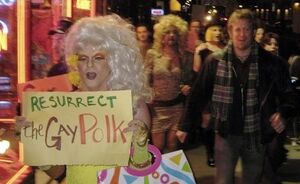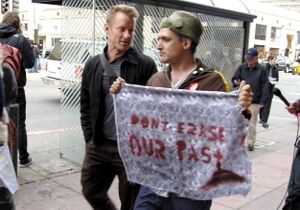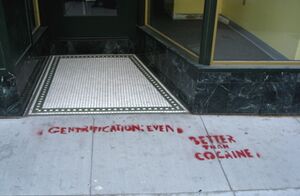Introduction
Text by Joey Plaster. Copyright (©) by C. Joey Plaster, 2009. All rights reserved.
Polk Street is popularly known as San Francisco’s premier gay male center in the 1960s and 1970s, predating the Castro and hosting the city’s first pride parades and Halloween celebrations. In later decades, the street was a national destination for queer runaway and homeless youth, immigrants from Asia and Latin America, and lower-income transgendered women.
By the mid-2000s, the neighborhood had changed dramatically, as the scores of low-income queer bars that formed the backbone of the Polk community were all but been replaced by upscale, heterosexual and “mixed” drinking establishments. During this time of transition, upscale condominiums, wine bars, and restaurants coexisted with homeless shelters, street prostitution, and low-income single room occupancy apartments.
The conflicts that accompanied these changes were framed in a variety of ways. A gay activist group blamed a newly formed neighborhood association for “destroying the last remaining public gathering place for marginalized queers” in a quest to “accelerate property development and real estate profiteering.”[1] A 2006 Wall Street Journal article characterized it as a battle between residents working to increase “cleanliness, beauty and safety” and those fighting to maintain the street’s “gritty ambience.”[2] The possible role of homophobia was highlighted in a 2005 Bay Area Reporter article about “efforts to ‘de-gay’ Polk Street.”[3]
In this essay I place these changes in historical context, arguing instead that they represent one of three major shifts in the street’s dominant economic bloc since the 1950s, largely driven by outside market and social forces in the context of a nationwide decrease in middle income central city neighborhoods.[4]
On Polk Street, a coveted bloc of central city space long zoned as a commercial corridor, the buck has always been the bottom line; the economic principles that would help create a gay commercial corridor in the late 1950s would also lead to its demise by the early 2000s.
This essay is not a comprehensive history of Polk Street. Instead, it is an attempt – by a non-economist – to trace the street’s primary economic shifts over the past sixty years. Polk Street is situated between several very different neighborhoods: the low-income Tenderloin area; the Van Ness commercial thoroughfare; the affluent, residential Nob Hill; Western Addition, a low-income African American neighborhood transformed by redevelopment in the 1950s; and the seat of government at Civic Center. As such, the relatively small swath of land in the city center has often been a flashpoint, providing a magnified view of issues such as housing, homelessness, real estate, and sexual politics that divide the city as a whole.
By the 1950s, a citywide shift from a blue-collar manufacturing to a white-collar office economy undercut an economic bloc on Polk Street made up of working class taverns and automobile manufacturing plants. As white residents left the city for the suburbs, gay men increasingly made their home in the city. By the early 1960s, in an effort to make San Francisco more competitive with the suburbs, the City redeveloped its “blighted” downtown as a financial hub, displacing the low-income queer communities that had taken root there, many of them to Polk Street. Taverns “went gay” to cash in on the gay market, gay businesses took over failing businesses, eventually banding together as the first gay business associations in the country. The expression of economic self-interest would also serve as a vehicle of upward economic mobility for an emerging gay political arena.
From the late 1970s to the mid-1980s, economic competition from the emerging Castro district, a national recession, a spike in commercial rents, and the AIDS health crisis devastated Polk Street’s gay bar and businesses economy. By the mid-1970s, construction of Bay Area Rapid Transit and “beautification” projects on Market Street in the early 1970s, part of the city’s continued transformation to a white-collar downtown, displaced an established male sex work economy to the Polk Street area. This economic bloc formed its own “underground” self-policing and protection mechanisms. After initial tension, including massive police sweeps ordered by the City at merchants’ behest, by the mid-1980s “aboveground” merchants’ decreased economic power translated to decreased political and policing power, and failing bars and businesses increasingly relied on the revenue sex workers generated. A sex work economy briefly emerged as the street’s dominant economic bloc.
By the 1990s, the fear and confusion surrounding AIDS led both to a decrease in the number of clients and a growing dependence on methamphetamine among sex workers, sapping the community of its health and economic strength. An increasingly desperate sex worker population that began competing for less and less money, eroding the cooperation and camaraderie that was a hallmark of the 1970s and leading to a more exploitative relationship between sex workers and clients. A growing economic dependence on drug sales and use undercut the support networks in the bars and on the street, ultimately leading to an increase in homelessness. The move to advertising in the back pages of newspapers, and later the emergence of the Internet as an advertising tool also undercut the sex work/bar economy. By the late 1990s and early 2000s, the dot.com housing crunch, rising citywide commercial rents, and an influx of artists and businesspeople seeking central city space led to a transition from a faltering, queer bar and sex work-based economy to an emerging, aboveground economy championed by a bloc of businesses, neighborhood associations, and residents working to attract a new set of clients to the area.
References
- ↑ http://www.gayshamesf.org/lpn.html
- ↑ “San Francisco’s red-light denizens fight to stay seedy,” The Wall Street Journal, October 24, 2006.
- ↑ “Concerns about efforts to ‘de-gay’ Polk Street,” Bay Area Reporter, Feb. 2005. From James Beales collection, San Francisco GLBTHS.
- ↑ A 2006 report by the Brookings Institution found that only 23 percent of central city neighborhoods in twelve large metropolitan U.S. areas were middle income in 2000, down from 45 percent in 1970. The study defined middle income as areas where families earn 80 to 120 percent of the local median income.


